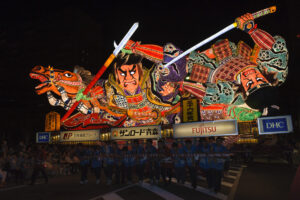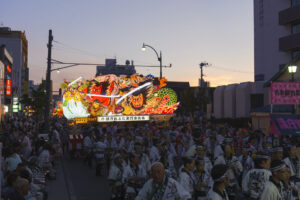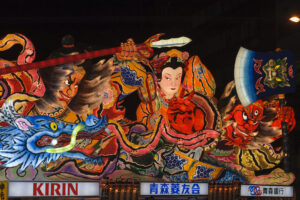Summer in Japan is certainly hot and humid, but it’s the time of year when you’re able to enjoy Japanese festivals called matsuri. From bon odori dancing to fireworks, there are tons of different ways to indulge in the Japanese tradition. Here’s an introduction to summer matsuri, including a few that you can enjoy in August!
Matsuri is more than just a celebration – it is a tradition deeply rooted in Japanese culture, religion, and community.
In Shinto, Japan’s indigenous religion, there is a belief that divine spirits exist in everything, from mountains and rivers to tools and everyday places. Thus, giving thanks and prayers to nature and the deities has become deeply rooted in Japanese culture and tradition. This is said to be the origin of matsuri.
There are many different types of matsuri that take place in Japan, but each has an aspect that is tied to religion. Bon odori dancing, which takes place during the Obon season in mid-August, started as a ritual of welcoming ancestors’ spirits. The mikoshi that is often seen carried at a matsuri is a sacred portable Shinto shrine believed to house a deity, and is carried throughout the town to bless the community. The lanterns (known as chochin in Japanese) that decorate matsuri venues are used to honor the dead, representing pure light that welcomes and honors the deities and other spirits. Even fireworks are tied to religion, as fire is portrayed as something sacred, and the very first firework festival that took place in Japan, the Sumidagawa Fireworks Festival, started as a ritual to mourn the dead.
Matsuri are held throughout the year, but summer sees the greatest number of them. This is because it is the time of year when typhoons and pests would ruin crops, and diseases would spread because of the humidity and heat, so the Japanese people had a tradition to conduct rituals to protect themselves from bad luck or evil influences, which eventually turned into the matsuri that we celebrate today.
So which ones should you visit when you’re in Japan? Here are a few of the major ones you are able to enjoy in August!
Nebuta (also called Neputa) is a matsuri that celebrates Tanabata, a summer celebration in which people write their wishes on colorful strips of paper and hang them on bamboo branches. It is also known as the “Star Festival”, as according to Japanese folklore, it is held on the only day of the year that the two stars, Altair and Vega, can meet. Held throughout Aomori Prefecture, Nebuta festivals are a parade of enormous human-shaped lantern floats accompanied by taiko drummers, musicians, and dancers.
The most popular of these is the Aomori Nebuta Matsuri, which takes place in Aomori City. The floats are a must see. They depict deities that are designed and constructed by local communities, a nearly year-long process. Each is handmade by traditional artisans, but at the Aomori Nebuta Festival, you can find Nebutas made by local children. Not only can you enjoy the sight, if you follow the rules, you can join the parade as a dancer on the day of!
Dates: August 2nd (Saturday) to 7th (Thursday)
Official Website: https://www.nebuta.jp/foreign/english.html



The Awa Odori Festival that takes place in Tokushima Prefecture is one of the most famous dance festivals in Japan. It takes place during Obon season every year, and welcomes more than one million people from across and outside Japan. It has a history of over 400 years, with some sources suggesting that it originated from Buddhist prayer rituals. The festival highlights dance groups known as ren, who wear traditional happi and yukata as uniforms and dance their way along a parade route. This year there will be 8 stages during the 5 day festival, where nearly 1,000 dance groups will perform. There are free stages but will definitely be crowded, so if you’re hoping to visit, be sure to buy tickets in advance.
Dates: August 11th (Monday) to 15th (Friday)
Official Website: https://www.awaodorimirai.com/
Yamaga is a small town in Kumamoto Prefecture, which is known for its washi paper and lanterns. An old story says that the townspeople of Yamaga helped the emperor of the time out of a dense fog by using pine torches to light his way, and ever since, the townspeople have continued to offer their light through lanterns, which has become a traditional craft good of the area.
The Yamaga Lantern Festival takes place here every Obon season, including a torch festival, fireworks, and dancing. Its highlight is the Sennin Toro Odori, where a total of 1,000 female performers wear golden Yamaga lanterns on their head and dance elegantly through the night. I have never been personally, but their official trailer shows a beautiful sight that cannot be found elsewhere. Entry is free for the festival itself, but tickets are needed for viewing the Sennin Toro Odori.
Dates: August 15th (Friday) & 16th (Saturday) *Sennin Toro Odori takes place on the 16th.
Official Website: https://yamaga-tanbou-jp-e.athp.transer.com/about/toromatsuri/
Bon odori dancing features traditional folk dances and music that pertains to each region. The Guji Odori Festival is special in that it is the longest running summer matsuri (it lasts more than 30 nights), and two of its dances are designated as a UNESCO Intangible Cultural Heritage. Its highlight is the bon odori dancing that is surprisingly held from 8pm to 5am for four consecutive nights during the Obon season. It will certainly be a night to remember, to dance throughout the night!
Dates: July 12th (Saturday) to September 6th (Saturday)
*All night bon odori are held from August 13th to 16th.
Official Website: http://www.gujohachiman.com/kanko/index_e.php
Whether you join in on the dancing or simply treat yourself with local snacks at the food stalls, take a step into tradition and enjoy the matsuri spirit!
Credits for images that don’t belong to WaWo Japan Travel can be viewed by hovering over the desired image.
<Author>
Saori Futsukaichi
Travel Consultant at WaWo Japan Travel
